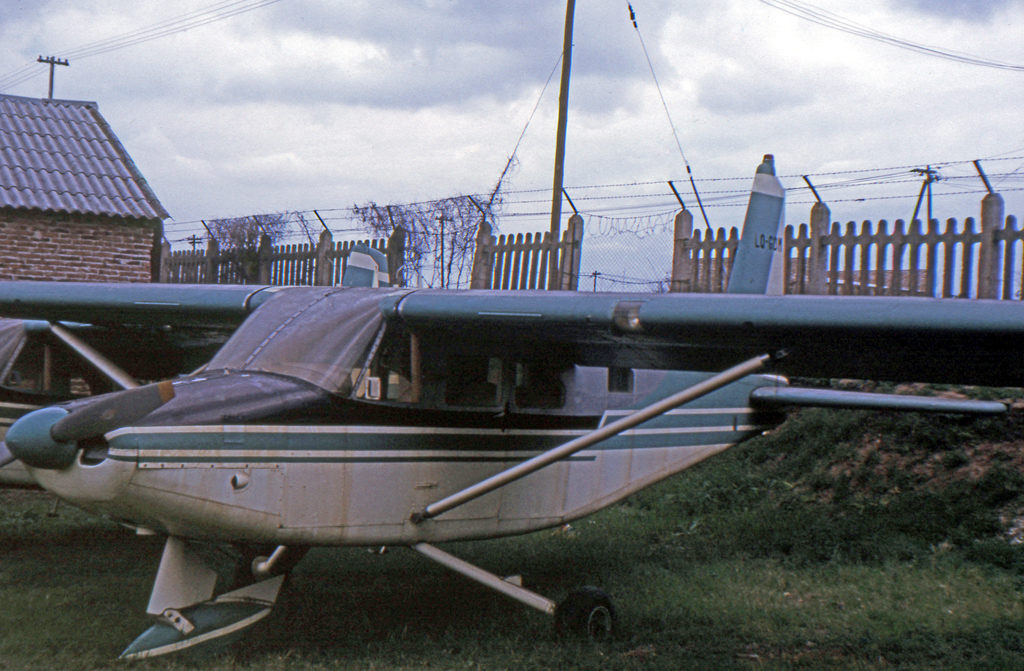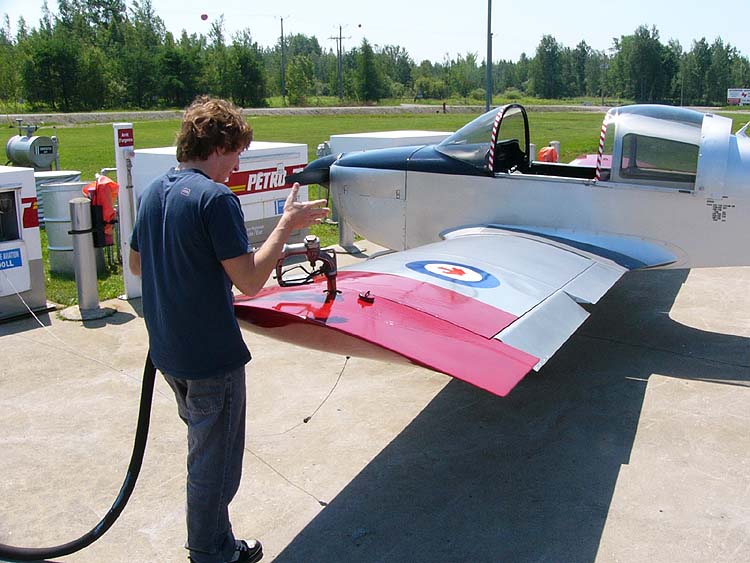|
Bush Plane
A bush plane is a general aviation aircraft used to provide both scheduled and unscheduled passenger and flight services to remote, undeveloped areas, such as the Canadian north or bush, Alaskan tundra, the African bush, or savanna, Amazon rainforest and the Australian Outback. They are used where ground transportation infrastructure is inadequate or does not exist. Common traits A bush plane is defined by how it is used, and many different aircraft with different configurations have been so used over the years. However, experience has shown certain traits to be desirable (though not mandatory), especially on aircraft specifically designed as bush planes. * Undercarriage designed to be fitted with floats, skis or wheel/skis to permit operation from water or snow—primarily for Canadian, Alaskan and Russian use. * High wings ease loading and unloading, particularly from docks; improve downward visibility during flight; and increase clearance to reduce the potential for damage ... [...More Info...] [...Related Items...] OR: [Wikipedia] [Google] [Baidu] |
Flap (aircraft)
A flap is a high-lift device used to reduce the stall (flight), stalling speed of an aircraft wing at a given weight. Flaps are usually mounted on the wing trailing edges of a fixed-wing aircraft. Flaps are used to reduce the take-off distance and the landing distance. Flaps also cause an increase in Drag (physics), drag so they are retracted when not needed. The flaps installed on most aircraft are partial-span flaps; spanwise from near the wing root to the inboard end of the ailerons. When partial-span flaps are extended they alter the spanwise lift distribution on the wing by causing the inboard half of the wing to supply an increased proportion of the lift, and the outboard half to supply a reduced proportion of the lift. Reducing the proportion of the lift supplied by the outboard half of the wing is accompanied by a reduction in the angle of attack on the outboard half. This is beneficial because it increases the margin above the Stall (fluid dynamics), stall of the outbo ... [...More Info...] [...Related Items...] OR: [Wikipedia] [Google] [Baidu] |
Antonov An-28
The Antonov An-28 (NATO reporting name Cash) is a twin-engined light turboprop transport aircraft, developed from the Antonov An-14M. It was the winner of a competition against the Beriev Be-30, for use by Aeroflot as a short-range airliner. It first flew in 1969. A total of 191 were built and 16 remain in airline service as at August 2015. After a short pre-production series built by Antonov, it was licence-built in Poland by PZL-Mielec. In 1993, PZL-Mielec developed its own improved variant, the PZL M28 Skytruck. Development The An-28 is similar to the An-14 in many aspects, including its wing structure and twin rudders, but features an expanded fuselage and turboprop engines, in place of the An-14's piston engines. The An-28 first flew as a modified An-14 in 1969. The next preproduction model did not fly until 1975. In passenger carrying configuration, accommodation was provided for up to 15 people, in addition to the two-man crew.Green, W. 1976. ''The Observer's Book of Air ... [...More Info...] [...Related Items...] OR: [Wikipedia] [Google] [Baidu] |
Antonov An-14
The Antonov An-14 Pchelka or Pchyolka, Bdzhilka (, "Little Bee", NATO reporting name: Clod)Taylor 1976, pp. 404–405. is a Soviet utility aircraft which was first flown on 15 March 1958.Stroud 1968, p. 65. It was a twin-engined light STOL utility transport, with two 300 hp Ivchenko AI-14RF Radial engine, radial piston engines. Serial production started in 1966, and about 300 examples were built by the time production ended in 1972. The An-14 failed to replace the more successful An-2 biplane, which was manufactured until 1990; the An-2 is still manufactured on special order. The An-14's successor, the An-28 with turboprop engines, is still manufactured at PZL Mielec factories in Poland, under the names PZL M28 Skytruck and PZL M28B Bryza. With very stable flight characteristics, the An-14 could be flown by most pilots after a few hours of basic training. A small number of An-14s are still in airworthy condition. History The development goal was a plane that was easy t ... [...More Info...] [...Related Items...] OR: [Wikipedia] [Google] [Baidu] |
Antonov An-2
The Antonov An-2 (USAF/DoD reporting name Type 22, NATO reporting name Colt) is a Soviet Union, Soviet mass-produced single-engine biplane utility/agricultural aircraft designed and manufactured by the Antonov Design Bureau beginning in 1947. Its durability, lifting power, and ability to take off and land from poor runways have given it a long service life. The An-2 was produced up to 2001 and remains in service with military and civilian operators around the world. The An-2 was designed as a utility aircraft for forestry and agriculture, but the basic airframe is adaptable and numerous variants have been developed. These include hopper-equipped crop-dusters, scientific versions for atmospheric sampling, water-bombers for fighting forest fires, air ambulances, seaplanes, and versions for dropping paratroopers.Harpole, Tom"Antonovs in America" [...More Info...] [...Related Items...] OR: [Wikipedia] [Google] [Baidu] |
Aermacchi AL-60
The Aermacchi AL-60 is a light civil utility aircraft of the late 1950s and early 1960s, originally designed by Al Mooney of Lockheed Corporation, Lockheed in the United States. After the company decided not to build the aircraft in the US, it was manufactured in small quantities in Mexico, and a few were assembled in Argentina (Santa Isabel, Córdoba) by Aviones Lockheed-Kaiser Argentina. It was also built in quantity under licence by Aermacchi in Italy and Atlas Aircraft Corporation in South Africa. Design and development In the late 1950s, the American aircraft designer Al Mooney, who had recently joined Lockheed Corporation, Lockheed after leaving Mooney International Corporation, the company that bore his name, was given the task of designing a utility aircraft, the CL-402, suitable for use in underdeveloped countries. As Lockheed could not build the design at an economic price in the United States, it was instead intended for the aircraft to be built under licence outside ... [...More Info...] [...Related Items...] OR: [Wikipedia] [Google] [Baidu] |
AAC Angel
__NOTOC__ The Angel Aircraft Corporation Model 44 Angel is a twin-engine STOL utility aircraft produced in the United States since the mid-1990s. Designed by Carl Mortenson and The King's Engineering Fellowship to be well-suited for missionary work from remote locations around the world, it is a low-wing cantilever monoplane with a retractable tricycle undercarriage and eight seats. The design is largely conventional, with the exception that the engine nacelles are mounted on top of the wings in a pusher configuration. Construction is aluminum throughout the airframe. Design work began at the home of designer Carl Mortenson in 1972, with work on the prototype beginning in 1977, also from the designer's home. In 1980 the project was moved to the municipal airport in Orange City, Iowa. The first flight took place on 13 January 1984, and FAA type certification was achieved on 20 October 1992. Angel Aircraft Corporation manufactures the aircraft under a license agreement with ... [...More Info...] [...Related Items...] OR: [Wikipedia] [Google] [Baidu] |
Jet Fuel
Jet fuel or aviation turbine fuel (ATF, also abbreviated avtur) is a type of aviation fuel designed for use in aircraft powered by Gas turbine, gas-turbine engines. It is colorless to straw-colored in appearance. The most commonly used fuels for commercial aviation are Jet A and Jet A-1, which are produced to a standardized international specification. The only other jet fuel commonly used in civilian turbine-engine powered aviation is Jet B, which is used for its enhanced cold-weather performance. Jet fuel is a mixture of a variety of hydrocarbons. Because the exact composition of jet fuel varies widely based on petroleum source, it is impossible to define jet fuel as a ratio of specific hydrocarbons. Jet fuel is therefore defined as a performance specification rather than a chemical compound. Furthermore, the range of molecular mass between hydrocarbons (or different carbon numbers) is defined by the requirements for the product, such as the freezing point or smoke point. Keros ... [...More Info...] [...Related Items...] OR: [Wikipedia] [Google] [Baidu] |
Avgas
Avgas (aviation gasoline, also known as aviation spirit in the United Kingdom, UK) is an aviation fuel used in aircraft with spark-ignited internal combustion engines. ''Avgas'' is distinguished from conventional gasoline (petrol) used in motor vehicles, which is termed ''mogas'' (motor gasoline) in an aviation context. Unlike motor gasoline, which has been formulated without lead since the 1970s to allow the use of catalytic converters for pollution reduction, the most commonly used grades of avgas still contain tetraethyllead, tetraethyl lead, a toxic lead-containing additive used to aid in lubrication of the engine, increase octane rating, and prevent engine knocking (spark-knock). There are ongoing efforts to reduce or eliminate the use of lead in aviation gasoline. Kerosene-based jet fuel is formulated to suit the requirements of gas turbine, turbine engines which have no octane requirement and operate over a much wider flight envelope than piston engines. Kerosene is also ... [...More Info...] [...Related Items...] OR: [Wikipedia] [Google] [Baidu] |
Turboprops
A turboprop is a gas turbine engine that drives an aircraft propeller. A turboprop consists of an intake, reduction gearbox, compressor, combustor, turbine, and a propelling nozzle. Air enters the intake and is compressed by the compressor. Fuel is then added to the compressed air in the combustor, where the fuel-air mixture then combusts. The hot combustion gases expand through the turbine stages, generating power at the point of exhaust. Some of the power generated by the turbine is used to drive the compressor and electric generator. The gases are then exhausted from the turbine. In contrast to a turbojet or turbofan, the engine's exhaust gases do not provide enough power to create significant thrust, since almost all of the engine's power is used to drive the propeller. Technological aspects Exhaust thrust in a turboprop is sacrificed in favor of shaft power, which is obtained by extracting additional power (beyond that necessary to drive the compressor) from turbine ... [...More Info...] [...Related Items...] OR: [Wikipedia] [Google] [Baidu] |
Piston Engines
A reciprocating engine, more often known as a piston engine, is a heat engine that uses one or more reciprocating pistons to convert high temperature and high pressure into a rotating motion. This article describes the common features of all types. The main types are: the internal combustion engine, used extensively in motor vehicles; the steam engine, the mainstay of the Industrial Revolution; and the Stirling engine for niche applications. Internal combustion engines are further classified in two ways: either a spark-ignition (SI) engine, where the spark plug initiates the combustion; or a compression-ignition (CI) engine, where the air within the cylinder is compressed, thus heating it, so that the heated air ignites fuel that is injected then or earlier.''Thermodynamics: An Engineering Approach'' by Yunus A. Cengal and Michael A. Boles Common features in all types There may be one or more pistons. Each piston is inside a cylinder, into which a gas is introduced, eit ... [...More Info...] [...Related Items...] OR: [Wikipedia] [Google] [Baidu] |
Bush Flying
Bush flying refers to aircraft operations carried out in the bush. Bush flying involves operations in rough terrain where there are often no prepared landing strips or runways, frequently necessitating that bush planes be equipped with abnormally large tires, skis, skids or any other equipment necessary for unpaved runway operation. It is the only viable way of delivering people and supplies into more difficult to reach, remote locations. Etymology This term ''bush'' has been used since the 19th century to describe remote wilderness area beyond clearings and settlements hence ''bush flying'' denotes flight operations carried out in such remote regions. In Australia, in particular, bush refers to areas that might be called forest or wilderness in other countries. Purpose Bush flying is the primary and sometimes the only method of access across Northern Canada, Western Canada, Alaska, the Australian Outback and many other parts of the world. History In Canada, the first real ... [...More Info...] [...Related Items...] OR: [Wikipedia] [Google] [Baidu] |







